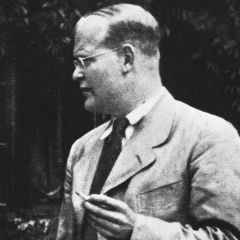
I’ve been dipping in an out of Dietrich Bonhoeffer’s Letters and Papers from Prison and was surprised to discover that he used the sign of the cross in his daily prayers.
In a letter from November 21, 1943, he says this: “I’ve found that following [Martin] Luther’s instruction to ‘make the sign of the cross’ at our morning and evening prayers is in itself most useful. There is something objective about it. . . .”
Growing up, I always understood the sign of the cross to be empty superstition. I am grateful to have learned otherwise since then and use it many times a day in prayer. (I talk about some of the reasons why here.) My old understanding has, however, left me prejudiced—I assume that evangelicals do not use it, let alone prescribe its use to others.
But then there’s Bonhoeffer, taking comfort in signing himself while imprisoned and Luther instructing every Lutheran since his own day to “bless yourself with the holy cross,” as he says in his Small Catechism. Luther actually instructed its use on other occasions as well, not only for morning and evening prayer, but also for baptism and ordination.
To double the intrigue, in the same letter Bonhoeffer says, “don’t suppose we go in very much for symbolism here [in prison]!” And also: “my fear and distrust of religiosity have become greater than ever here.” And yet he signs himself. Why?
Signing oneself is not merely a symbol. It is, as Bonhoeffer says, “objective.” There is something tangible and actual about it. Second, signing oneself is not mere religiosity. It’s communion with God. That is because, at bottom, the act of faithfully signing the cross is an act of prayer, one that is physical, a remembrance, a benediction, a collect that gathers every trial, worry, and fear, and consigns it to the care of Christ.
It can also be used to express gratitude at a meal, joy at a blessed occurrence, repentance in a moment of sin, resistance in a moment of temptation, and faith when undertaking any task (with emphasis on the any).
It’s always been this way in the church. As Tertullian wrote in the year 204 in an essay called The Crown, “At every forward step and movement, at every going in and out, when we put on our clothes and shoes, when we bathe, when we sit at table, when we light the lamps, on couch, on seat, in all the ordinary actions of daily life, we trace upon the forehead the sign [of the cross].”
Christ bore the cross for every needful thing in our life, and we demonstrably acknowledge as much in its sign. Bonhoeffer said the sign of the cross was objective, “and that is what is particularly badly needed here.” Here, too.















